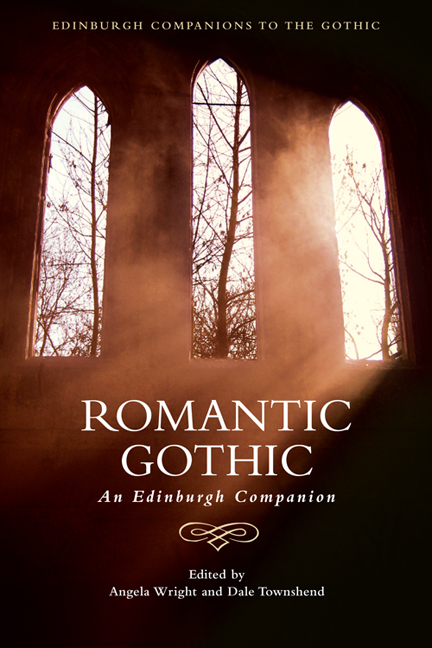Book contents
- Frontmatter
- Contents
- 1 Gothic and Romantic: An Historical Overview
- Part I Gothic Modes and Forms
- 2 Graveyard Writing and the Rise of the Gothic
- 3 Gothic Romance
- 4 The Gothic Stage: Visions of Instability, Performances of Anxiety
- 5 Gothic Poetry and First-Generation Romanticism
- 6 Gothic and Second-Generation Romanticism: Lord Byron, P. B. Shelley, John Polidori and Mary Shelley
- 7 Political Gothic Fiction
- 8 Shorter Gothic Fictions: Ballads and Chapbooks, Tales and Fragments
- 9 Oriental Gothic
- 10 Gothic Parody
- Part II National and International Borders
- Part III Reading the Romantic Gothic
- Notes on Contributors
- Index
6 - Gothic and Second-Generation Romanticism: Lord Byron, P. B. Shelley, John Polidori and Mary Shelley
from Part I - Gothic Modes and Forms
Published online by Cambridge University Press: 05 August 2016
- Frontmatter
- Contents
- 1 Gothic and Romantic: An Historical Overview
- Part I Gothic Modes and Forms
- 2 Graveyard Writing and the Rise of the Gothic
- 3 Gothic Romance
- 4 The Gothic Stage: Visions of Instability, Performances of Anxiety
- 5 Gothic Poetry and First-Generation Romanticism
- 6 Gothic and Second-Generation Romanticism: Lord Byron, P. B. Shelley, John Polidori and Mary Shelley
- 7 Political Gothic Fiction
- 8 Shorter Gothic Fictions: Ballads and Chapbooks, Tales and Fragments
- 9 Oriental Gothic
- 10 Gothic Parody
- Part II National and International Borders
- Part III Reading the Romantic Gothic
- Notes on Contributors
- Index
Summary
There is a definite point of passage between uses of the Gothic by Wordsworth, Coleridge and Mary Robinson, among others, and the striking reworkings of the Gothic by several authors we now call the ‘second generation’ of English Romantics. This point is the ‘ghoststory contest’ proposed by Lord Byron in June 1816 at the Villa Diodati he rented by Lake Geneva in Switzerland, where he hosted, among others, Percy Bysshe Shelley, Mary Godwin (Mary Shelley by December) and Byron's personal physician and occasional homosexual partner, Dr John Polidori, the keeper of a diary during that whole time (Sunstein 1989: 117–22). That challenge began, Polidori tells us, with an immersion in earlier Gothic: a group reading of Fantasmagoriana (1812), a French translation by Jean Baptiste Eyriés of German Gothic tales (Mary Shelley 1982: 7n.) imitative of Walpole's The Castle of Otranto (1764; see Utterson 1813: i), and Byron's recitation of Coleridge's ‘Christabel’, just published in 1816, though mostly as its author had left it in 1800. From this confluence emerged a great deal of important writing: Byron's own extensions of the Gothic in The Prisoner of Chillon and Other Poems (December 1816) and his verse-drama Manfred (1817) – leading later to the ‘Norman Abbey’ cantos in Don Juan (left incomplete when he died at Missolonghi in 1824) – then Mary's novel Frankenstein (1818) and Polidori's novella The Vampyre (1819), perhaps the two most influential of all Gothic fictions to this day, as well as P. B. Shelley's tragedy The Cenci (1819), parts of his later poetry, and Mary's subsequent novels and stories as she proceeded to outlive all of the men at Diodati.
The lasting power of these works, I want to show here, comes less from how these authors intensify the Gothic in ‘first-generation’ Romantic writing and more from how they radicalise the features and underpinnings of the Gothic mode itself. Walpole's Otranto and the Preface to its second edition (1765) define the new ‘Gothic Story’ as a ‘blend’ of ‘two kinds of romance, the ancient’, the supernaturally assisted quest-tales of old Greece and medieval Catholicism as adapted by Shakespeare, Spenser and others, and ‘the modern’, the Protestant eighteenth-century fictions of Defoe, Richardson, Fielding and Smollett grounded, mostly, in empirically based motivations and actions (Walpole 2003: 65).
- Type
- Chapter
- Information
- Romantic GothicAn Edinburgh Companion, pp. 112 - 128Publisher: Edinburgh University PressPrint publication year: 2015

